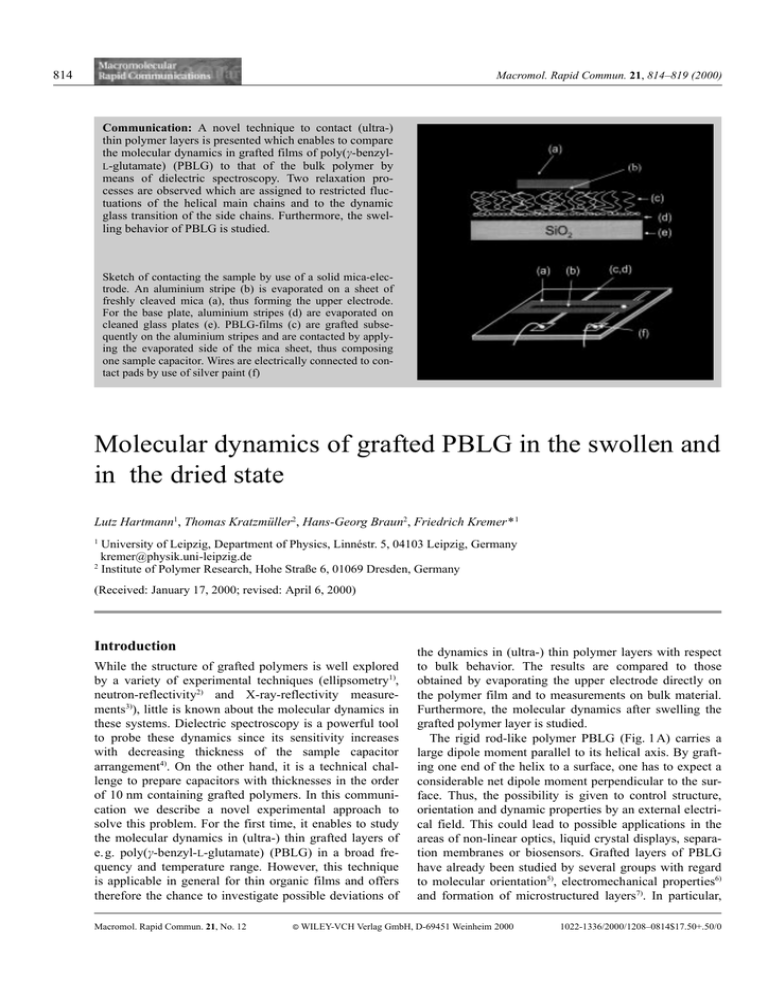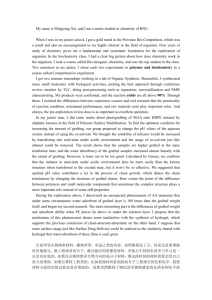Molecular dynamics of grafted PBLG in the swollen and in the dried
advertisement

814 Macromol. Rapid Commun. 21, 814–819 (2000) Communication: A novel technique to contact (ultra-) thin polymer layers is presented which enables to compare the molecular dynamics in grafted films of poly(c-benzylL-glutamate) (PBLG) to that of the bulk polymer by means of dielectric spectroscopy. Two relaxation processes are observed which are assigned to restricted fluctuations of the helical main chains and to the dynamic glass transition of the side chains. Furthermore, the swelling behavior of PBLG is studied. Sketch of contacting the sample by use of a solid mica-electrode. An aluminium stripe (b) is evaporated on a sheet of freshly cleaved mica (a), thus forming the upper electrode. For the base plate, aluminium stripes (d) are evaporated on cleaned glass plates (e). PBLG-films (c) are grafted subsequently on the aluminium stripes and are contacted by applying the evaporated side of the mica sheet, thus composing one sample capacitor. Wires are electrically connected to contact pads by use of silver paint (f) Molecular dynamics of grafted PBLG in the swollen and in the dried state Lutz Hartmann1, Thomas Kratzmüller2, Hans-Georg Braun2, Friedrich Kremer* 1 1 University of Leipzig, Department of Physics, Linnéstr. 5, 04103 Leipzig, Germany kremer@physik.uni-leipzig.de 2 Institute of Polymer Research, Hohe Straße 6, 01069 Dresden, Germany (Received: January 17, 2000; revised: April 6, 2000) Introduction While the structure of grafted polymers is well explored by a variety of experimental techniques (ellipsometry1), neutron-reflectivity2) and X-ray-reflectivity measurements3)), little is known about the molecular dynamics in these systems. Dielectric spectroscopy is a powerful tool to probe these dynamics since its sensitivity increases with decreasing thickness of the sample capacitor arrangement4). On the other hand, it is a technical challenge to prepare capacitors with thicknesses in the order of 10 nm containing grafted polymers. In this communication we describe a novel experimental approach to solve this problem. For the first time, it enables to study the molecular dynamics in (ultra-) thin grafted layers of e. g. poly(c-benzyl-L-glutamate) (PBLG) in a broad frequency and temperature range. However, this technique is applicable in general for thin organic films and offers therefore the chance to investigate possible deviations of Macromol. Rapid Commun. 21, No. 12 the dynamics in (ultra-) thin polymer layers with respect to bulk behavior. The results are compared to those obtained by evaporating the upper electrode directly on the polymer film and to measurements on bulk material. Furthermore, the molecular dynamics after swelling the grafted polymer layer is studied. The rigid rod-like polymer PBLG (Fig. 1 A) carries a large dipole moment parallel to its helical axis. By grafting one end of the helix to a surface, one has to expect a considerable net dipole moment perpendicular to the surface. Thus, the possibility is given to control structure, orientation and dynamic properties by an external electrical field. This could lead to possible applications in the areas of non-linear optics, liquid crystal displays, separation membranes or biosensors. Grafted layers of PBLG have already been studied by several groups with regard to molecular orientation5), electromechanical properties6) and formation of microstructured layers7). In particular, i WILEY-VCH Verlag GmbH, D-69451 Weinheim 2000 1022-1336/2000/1208–0814$17.50+.50/0 815 Molecular dynamics of grafted PBLG in the swollen and in the dried state means of a nitrogen gas jet, thus obtaining a stability better than l 0.05 K10). For the analysis of dielectric spectra, the imaginary part e99 of the dielectric function is fitted using a superposition of a conductivity contribution and a generalized relaxation function according to Havriliak-Negami (Eq. (1))11). The activation behavior of the side-chain fluctuation for the different samples could be described by the Vogel-Fulcher-Tammann law (Eq. (2))12): e99 r0 a De ÿ Im a c e0 xs 1 ixsHN s so e Fig. 1. (A) Primary and secondary structure of poly(c-benzylL-glutamate) (PBLG). (B) Sketch of contacting the sample by use of a solid mica-electrode. An aluminium stripe (b) is evaporated on a sheet of freshly cleaved mica (a), thus forming the upper electrode. For the base plate, aluminium stripes (d) are evaporated on cleaned glass plates (e). PBLG-films (c) are grafted subsequently on the aluminium stripes and are contacted by applying the evaporated side of the mica sheet, thus composing one sample capacitor. Wires are electrically connected to contact pads by use of silver paint (f) the molecular dynamics of poly(glutamates) in the bulk is well understood: It is known that PBLG has two dielectrically active relaxation processes which are assigned to (restricted) fluctuations of the helical main chain as a whole (chop stick motion) and to fluctuations of the side groups8, 9). Results and discussion Dielectric measurements in a frequency range from 10–1 Hz to 106 Hz were performed using a SolartronSchlumberger frequency response analyzer FRA 1 260 with a Novocontrol active sample cell (BDC-S). Effects due to a non-linear response of the sample were excluded by setting the generator voltage to 0.4 V. Thus, electrical fields of 1.3 6 105 V cm–1 within the sample were applied. The sample temperature was controlled by ÿ 1 DT0 TÿT0 2 In this notation, e0 is the vacuum permittivity, r0 the DC-conductivity and De the dielectric strength. For Ohmic behavior, s equals one; deviations (s a 1) are caused by electrode polarization. The correct dimension for s m 1 is obtained by the factor a: [a] = (H N z)s-1. Parameters a and c describe the symmetric and asymmetric broadening of the relaxation time distribution function. From fits according to Eq. (1), the relaxation rate 1/smax can be deduced which is given by the frequency of maximum dielectric loss e99 for a certain temperature. In Eq. (2), D is a measure for the fragility of the glass-forming substance13), T0 is the Vogel temperature and s0 denotes the limit of the relaxation time at high temperatures. Bulk samples were prepared as films obtained from the pressed molten PBLG and as cast films from a concentrated chloroformic solution of the polymer. Further measurements with the latter were carried out after drying the sample for several days. Both types of bulk samples were contacted by placing the film between two gilded brass electrodes. For good electric contact, a thin aluminium foil was brought between sample and electrodes. Furthermore, bulk samples were prepared as solution cast films on the same type of substrate which was used for measurements on the grafted layers. The thickness of all samples was measured with a Veeco Instruments alpha stepper. Independent of the preparation, all bulk samples deliver identical dielectric spectra except a rise in the loss e99 above 105 Hz due to the electrode resistance in case of evaporated electrodes (Fig. 2). This effect has also been observed in measurements on grafted layers and is due to the electrode resistance R (less than 10 X) which leads to an equivalent parallel RC circuit (C denotes the sample capacity). A more detailed description of this effect can be found in ref.14) For preparation of grafted layers, glass substrates were cut out of microscope slides, cleaned first by ultrasonification in a chloroform bath and then in a solution of a commercial detergent (Hellmanex) in ultrapure water 816 L. Hartmann, T. Kratzmüller, H.-G. Braun, F. Kremer Fig. 2. Dielectric loss e 99 of a bulk sample cast from solution (j) and of a grafted layer (C = contacted by a solid top electrode, F = evaporated aluminium stripes as top electrode; for both cases data are corrected as explained in the text) of PBLG at 416 K and 318 K with the corresponding numerical fits. The relaxation process at 416 K corresponds to the restricted motion of the helical main chains (chop-stick-motion), that one at 318 K corresponds to the motion of the side chains. The second process at low frequencies in the grafted layer at 416 K is assigned to an electrode polarization process. Data of the relaxation processes are fitted to the Havriliak-Negami function ( N N N polarization process, — conductivity). The solid lines indicate the two different relaxation processes while the thick solid lines represent the sum of all contributions. Two typical sets of fit parameters are given for the bulk sample: 318 K: De = 0.66, s = 1.4 N 10–5 s, a = 0.65, c = 0.496; 416 K: De = 2.496, s = 0.0245 s, a = 1, c = 1, r0 = 3.93 N 10–10 S N m–1, s = 0.82 drawn from a Millipore water system. After thoroughly rinsing with ultrapure water, the substrates were blown dry with nitrogen and subsequently put into the recipient of a Leybold metal coater for evaporation of three parallel aluminium electrodes of about 70 nm thickness. The (ultra-) thin grafted PBLG layers were obtained by a surface initiated polymerization process of the corresponding N-carboxy anhydride (NCA)7). First the cleaned aluminium surfaces were modified by adsorption of 1-phosphoric acid, 12-N-ethylaminododecane which serves as initiator layer for the polymerization. In a second step, the so altered surface reacts with a solution of the NCA of c-benzyl-L-glutamate in THF. After 24 h, the substrates were removed from the solution and washed with chloroform. The thickness (30 l 5) nm of the layer was determined by means of ellipsometry. Before further treatment, the samples were dried in an oil-free vacuum (10–5 mbar) at 60 8C. Subsequently, the top electrode has been established either by a second evaporation of aluminium or by application of the mica method as described in the following: The straight-forward approach to contact (ultra-) thin polymer layers is to evaporate a metal counterelectode4, 14). This technique has the serious drawback that it often results in electrical shortcuts since (ultra-) thin polymer layers are never free of defects. Moreover, in order to ensure an acceptable electric conductivity of the electrode, one has to evaporate a metal layer (e. g. Au, Ag or Al) of about 70 nm thickness on the underlying polymer film having a thickness of about 50 nm. Taking this into account, one has to envisage artifacts for the structure and for the dynamics of the grafted layer after this treatment. These difficulties are circumvented by our new technique to contact (ultra-) thin polymer layers. To prepare the grafted polymer in a capacitor arrangement, the grafted layer is covered with a freshly cleaved lamella of mica (thickness 5 lm) which was previously evaporated with aluminium stripes having a thickness of 70 nm. Thus, a sample capacitor with an area of 2 mm2 is formed (Fig. 1 B). Mica offers the advantage that it shows atomically flat surfaces after being cleaved off. To maintain this purity of the surfaces, the mica was cleaved in a flow box and placed in a small box immediately afterwards where it could be kept under protection gas (pure nitrogen). This box was mounted in the evaporation apparatus (Leybold Univex 300) where it was opened after evacuation of the evaporation chamber by means of a remote control. Thus, contamination of the mica surface and, after evaporation, of the electrode surface was avoided. A comparison between bulk sample, grafted layer with evaporated electrodes and grafted layer prepared with the novel mica method delivers similar results for the dynamic glass transition of the side chains (in contrast to the chop stick motion at higher temperatures; see below). In case of the side chain fluctuation, the spectra of e 99 obtained on the grafted layer are broadened in comparison to the bulk data (for both preparation techniques) and the relaxation time smax determined by the maximum position of e 99 is shifted to longer times (Fig. 2 and Fig. 3). It is immediately clear that one can not assume to have contact between the upper electrode and the polymer layer over the whole contact area. Consequently, one has to expect distinct differences between the measured capacity and the calculated value according to the geometry of the sample capacitor. The data of the dielectric loss e 99 Molecular dynamics of grafted PBLG in the swollen and in the dried state Fig. 3. Activation plot for the two relaxation processes in dried and swollen state. The solid symbol f denotes both processes of the bulk measurement for an unswollen sample. The corresponding measurements on the grafted layer are denoted by the open symbols: C and D are used to mark the fluctuation of the helical main chains and the electrode polarization process at high temperatures (mica technique), F- and G indicate the data of the side chain motion obtained by use of evaporated electrodes and of the mica method, respectively. * is used to denote the side chain fluctuation after the swelling procedure. In this case, S denotes the starting point and E denotes the end of the measurement of the swollen sample. Fits according to the VFT law are shown by solid lines for the bulk and for the (ultra-) thin film before the swelling procedure. The following fit parameters were obtained for the bulk: log (1/s0) = 10.3, D N T0 = 670.8 K, T0 = 264.5 K and for the grafted layer: log (1/s0) = 11.9, D N T0 = 1 270.2 K, T0 = 240.3 K. Arrows indicate the dielectrically determined values for the glass transition temperature Tg, i. e. the temperature which corresponds to a relaxation rate of smax = 100 s: Tgbulk = (280 l 2) K, Tglayer = (287 l 2) K show this discrepancy as well, but the spectra can be brought into quantitative accordance by multiplying the measured values of e 99 with the ratio evbulk/evgrafted, where ev denotes the high frequency values of the real part e 9 of the dielectric function: e99corrected ebulk v e99measured egrafted v 3 Corrected values for e 99 of the grafted layer obtained by following this procedure are shown in Fig. 2. The remaining differences between the bulk spectra and those of the grafted layer with evaporated electrodes can be explained by errors in the determination of the layer thickness and of the contact area of the electrodes due to the surface roughness of the polymer film. The introduced corrections are important for the discussion of the dielectric strength De; the frequency position of the maximum loss, corresponding to smax, is not influenced by these effects. One has to state that, as an advantage of the new technique of contacting (ultra-) thin polymer films, the observation of the chop stick motion became only possible if a solid upper electrode was used. In this case, a second relaxation process occurred which is assigned to an electrode polarization effect because of its comparatively high dielectric strength and the fact that it is the slowest of all observed processes. In contrast, the evaporation of metal electrodes led to noisy spectra at high temperatures which did not permit the analysis of the dielectric loss using Eq. (1). Consequently, information concerning the chop stick motion within the grafted layer is lost in case of evaporated electrodes. The spectra of e 99 of the dynamic glass transition of the side chains within the grafted layer are much broader than those of the bulk sample. This effect of a broadening of the relaxation time distribution is in accordance with findings of similar measurements on thin films4, 14), as well as on low molecular weight glass forming liquids confined to a nanoporous matrix15–18). While in the cited publications, this result was estimated as an indication for the existence of cooperative rearranging regions (CRR) which determine the dynamics in vicinity of the glass transition temperature Tg, this explanation does not hold in our case. Since side chain fluctuations should not be affected by the geometric confinement, we explain our findings by the assumption that the potential governing the dynamics of the side-chain dipoles is more heterogeneous in the grafted layer than in the bulk, thus leading to a broadening and a slowing down of this process. All spectra of the side chain fluctuation were fitted to the equation of Havriliak and Negami and thus the activation plot (Fig. 3) has been obtained. Concerning the thermal activation, one has to point out that the local fluctuation of the side chains would be expected to have an Arrhenius-like activation behavior. This was indeed found for glutamates with methyl side chains only19). However, for PBLG or similar substances with longer side chains, the thermal activation of the corresponding relaxation can be well described by the VFT law8, 14), thus indicating that in these cases the side chains undergo a glass transition. As a further difference between bulk and grafted layer besides the broadening of the relaxation time distribution, it is found that the dynamic glass transition of the side chains in the (ultra-) thin grafted layer is slowed down in 817 818 L. Hartmann, T. Kratzmüller, H.-G. Braun, F. Kremer comparison to the bulk (Fig. 3). Since these differences between bulk and grafted layer were obtained independently of the preparation of the bulk sample and of the way of contacting the (ultra-) thin layer, they have to be attributed either to the different structure of both films or to the decreased thickness of the grafted layer. To decide this question, further investigations into grafted films with different thicknesses and spin-coated films of PBLG have to be done. The chop stick motion in the grafted layer is found to be faster than in the bulk reference. This can be explained by the assumption that the molecular weight of the grafted PBLG is smaller than in the bulk. The determination of both values is in progress. To improve the contact between layer and upper electrode, PBLG was swollen in a chloroform atmosphere for several hours. As result of this procedure, a higher capacity was achieved which was in better agreement with calculated values. The calculated capacity is 8 6 10–10 F, while the measured value was around 3 6 10–10 F. Furthermore as a result of the swelling procedure, the side chain fluctuation becomes faster in the swollen sample (Fig. 3). With increasing temperature, the content of chloroform decreases, and the relaxation rate tends to the values of the unswollen sample. Measurement from high to low values of the temperature results in the same thermal activation as the unswollen sample, thus indicating that the swelling process is fully reversible. The chop stick motion is not affected by the swelling procedure. The dielectric strength De of the side chain fluctuation can be well described by De nl2eff 3kTe0 Fig. 4. Relaxation strength De of the side chain fluctuation for the grafted layer (corrected values; C – evaporated electrodes, D – mica technique) and for the bulk (f). Calculated values according to Eq. (4) are given by the dashed line (- - -) 4 where n denotes the density of dipoles and leff their effective dipole moment. The calculated values in Fig. 4 were obtained by assuming leff = 1.1 D6) and n = 5 6 1021 cm–3. The latter value is well comparable with an estimation taking into account approximate values for chain length (60 nm) and grafting density (0.005 Å–2). The comparison between calculated and measured values is shown in Fig. 4. While there is a good agreement between calculation and the corresponding measurements on bulk and grafted layer prepared according to the mica method, De is notably higher when the electrodes were evaporated. This difference is attributed to changes within the grafted layer during the evaporation of aluminium. Concerning the chop stick motion, it has to be considered that this motion is restricted by interactions between neighboring chains and by fixing one end of the chains to the electrode surface leading to a reduction of De (Fig. 5) compared to the expected values according to Eq. (4). This situation corresponds to the model of Wang and Pecora20) who described the restricted rotational diffusion Fig. 5. Relaxation strength De of the fluctuation of the helical main chains: D denotes the corrected values of the grafted layer contacted by the mica technique, while f is used for bulk values. The inset illustrates the restricted chop-stick-motion according n indicates the length axis to the model of Wang and Pecora20): ~ of the rod-like molecule and h0 the apex angle of the cone which restricts the fluctuation of the rod-like molecule having a tilt angle h Molecular dynamics of grafted PBLG in the swollen and in the dried state of rod-like molecules. Thereby, the fluctuation of the molecule length axis is constrained to a cone with an apex angle h0 (inlet in Fig. 5). In the frame of this model, it is possible to deduce a relation connecting Derod for the free fluctuation of helical main chains according to Eq. (4) and the values Dechopstick obtained from the fits: 1 2 Dechopstick Derod 1 ÿ 1 cosh0 4 5 Application of Eq. (5) to the data delivers an angle h0 of approximately 2 8 which corresponds well to ref.8) There, similar glutamic acid containing polymers have been investigated by means of dielectric spectroscopy; for evaluation of the bulk data, the model of Wang and Pecora has been applied as well. Acknowledgement: The authors are grateful to Dr. Iris Maege (Institut für Makromolekulare Chemie, TU Dresden) for the synthesis of the 1-phosphoric acid, 12-N-(ethylamino)dodecane initiator. Financial support within the Sonderforschungsbereiche 294 “Moleküle in Wechselwirkung mit Grenzflächen” and 287 “Reaktive Polymere in nichthomogenen Systemen, in Schmelzen und an Grenzflächen” is highly acknowledged. 1) 2) 3) 4) 5) 6) 7) Conclusions In summary, a novel method is introduced which to our best knowledge enables for the first time to study the molecular dynamics in (ultra-) thin layers of grafted PBLG. The results are compared to measurements on bulk samples and on grafted PBLG layers contacted by evaporating metal electrodes. Two relaxation processes are observed which are assigned to (restricted) fluctuations of the helical main chains as a whole (chop stick motion) and to the dynamic glass transition of the side chains. The latter shows a VFT-temperature dependence which scales well with calorimetric measurements9). Its relaxation time distribution is broadened in case of the grafted layers with respect to the bulk, and its relaxation rate smax is slightly shifted to longer times. The chop stick motion within the grafted layer can only be observed when the mica method is applied. Results obtained for the dielectric strength De are in good agreement with calculations based on free dipole fluctuations (side-chain motion) and on the model of Wang and Pecora (chop stick motion). Swelling the polymer with chloroform leads to a faster motion of the side chains. This effect is fully reversible. 8) 9) 10) 11) 12) 13) 14) 15) 16) 17) 18) 19) 20) A. Heise, H. Menzel, H. Yim, M. D. Foster, R. H. Wieringa, A. J. Schouten, V. Erb, M. Stamm, Langmuir 13, 723 (1997) P. Lambooy, T. P. Russell, G. J. Kellog, A. M. Mayes, P. D. Gallagher, S. K. Satija, Phys. Rev. Lett. 72, 2899 (1994) G. Tourillon, A. Fontaine, R. Garrett, M. Sagurton, P. Xu, G. P. Williams, Phys. Rev. B (Condens. Matter) 35, 9863 (1987) K. Fukao, Y. Miyamoto, Europhys. Lett. 46, 649 (1999) Y. C. Chang, C. W. Frank, G. G. Forstmann, D. Johannsmann, J. Chem. Phys. 111, 6136 (1999) T. Jaworek, D. Neher, G. Wegner, R. H. Wieringa, A. J. Schouten, Science 279, 57 (1998) Th. Kratzmüller, D. Appelhans, H.-G. Braun, Adv. Mater. 11, 555 (1999) A. Schmidt, S. Lehmann, M. Georgelin, G. Katana, K. Mathauer, F. Kremer, K. Schmidt-Rohr, C. Boeffel, G. Wegner, W. Knoll, Macromolecules 28, 5487 (1995) H. Block, “Poly(c-benzyl-L-glutamate) and other glutamic acid containing polymers”, 1st edition, Gordon and Breach Science Publishers Inc., New York 1983 F. Kremer, D. Boese, G. Maier, E. W. Fischer, Prog. Polym. Sci. 80, 129 (1989) S. Havriliak, S. Negami, J. Polym. Sci. Part C 14, 99 (1966) G. Tammann, W. Z. Hesse, Anorg. Allgem. Chemie 156, 245 (1926) C. A. Angell, B. E. Richards, V. Velikow, J. Phys.: Condens. Matter 11, A75 (1999) G. Blum, F. Kremer, T. Jaworek, G. Wegner, Adv. Mater. 7, 1017 (1995) M. Arndt, R. Stannarius, W. Gorbatschow, F. Kremer, Phys. Rev. E 54, 5377 (1996) J. Schüller, Y. B. Mel’nichenko, R. Richert, E. W. Fischer, Phys. Rev. Lett. 73, 2224 (1994) A. Huwe, F. Kremer, P. Behrens, W. Schwieger, Phys. Rev. Lett. 82, 2338 (1999) W. Gorbatschow, M. Arndt, R. Stannarius, F. Kremer, Europhys. Lett. 35, 719 (1996) Y. Tsujita, I. Uematsu, Polym. J. 6, 274 (1974) C. C. Wang, R. Pecora, J. Chem. Phys. 72, 5333 (1980) 819




